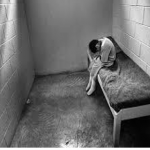Proof that “the arts can eliminate some trauma” was also attested to by Dave Mitchell who pointed out that there are now only 330 incarcerated juveniles in a residential system that housed over 1500 not so long ago. Mitchell and the others say what is different with their approach using art is, “We don’t want to control, we want to change them.” Clearly the program is achieving a revolutionary result by enabling kids who start out violent, defensive, and closed off, to become open and able to access their soft cores without the fear that has been such a pervasive force in their lives.
Up until now, these “circumstantial barriers” have had a far greater impact on juveniles of color, where by every measure of severity from the initial response of police to whether or not the juvenile is incarcerated– and for how long — disproportionally impacts minority youth far more than their White counterparts.
Ironically, whether it’s the juvenile justice system with its subsequent incarceration or in our public education system that is marked by an endemic lack of rigor, what seems to be driving both to the detriment of society iscorporate profit, no matter what the human cost.
Can anyone honesty say that instituting an effective arts education in theproposed publicly funded $3.7 billion jail expansion planned for a Miraloma location would not be a preferable way to try and address the current broken system of juvenile justice? It’s something to consider, especially since, as Kim McGill points out,the present system costs approximately $247,000 for every year a juvenile spends in “camp.”
And this is only the tip of the fiscal iceberg, when one considers that 70% of today’s incarcerated juvenile population is to some degree mentally ill, which will only get worse if left untreated. Up until now, the punitive system of incarceration has had neither the will nor the financial ability to deal with this in a timely manner.
How much of what they deal with on a day to day basis would be unnecessary if school districts like LAUSD did their job and stopped socially promoting students from grade to grade without mastering prior grade-level standards.
© Humane Exposures / Susan Madden Lankford









